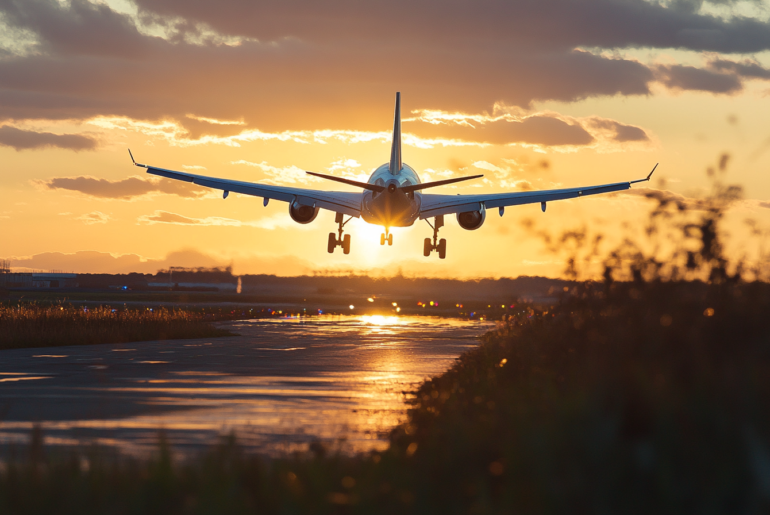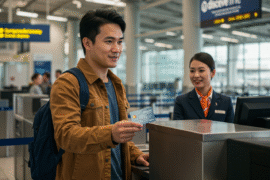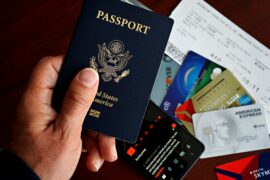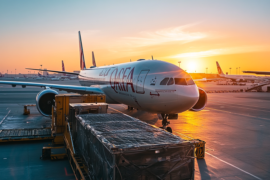This article may contain references to products or services from one or more of our advertisers or partners. We may receive compensation when you click on links to those products or services. Nonetheless, our opinions are our own.
The information presented in this article is accurate to the best of our knowledge at the time of publication. However, information is subject to change, and no guarantees are made about the continued accuracy or completeness of this content after its publication date.
- Key Highlights
- Introduction
- Understanding the Surge in Air Travel
- Beginner’s Guide to Planning Around Busy Flight Days
- Strategies for Avoiding Airport Chaos
- Conclusion
-
Frequently Asked Questions
- What are the busiest travel days around Thanksgiving and Christmas?
- How early should I arrive at the airport on peak travel days?
- What are the busiest days of the week to fly?
- Are there certain times of the year when airports are especially crowded?
- How can I avoid long lines and delays at the airport during peak travel times?
- Are there any strategies for navigating through busy airports more efficiently?
- Recommended Reads
Key Highlights
- The busiest air travel days are typically around major holidays like Thanksgiving, Christmas, and New Year’s Day.
- Fridays, Sundays, and Mondays are generally the most crowded days at airports due to leisure and business travelers.
- Booking flights in advance, especially for holiday travel, can often help secure better deals and avoid last-minute price surges.
- Utilizing programs such as TSA PreCheck, Global Entry, or CLEAR can significantly expedite security processes at the airport.
- Staying informed about potential travel disruptions caused by weather or other unforeseen events can help you adapt your plans and ensure a smoother journey.
Introduction
Air travel becomes significantly busier during holidays and special times of the year. To avoid large crowds, long waits, and possible delays, it is essential to understand the busiest travel days. This guide explores peak travel periods, tips for reducing airport stress, and ways to plan your trips more efficiently.
Understanding the Surge in Air Travel
Holiday travel significantly increases passenger numbers at airports. Many people fly to visit family, take vacations, or travel for work. This surge in travelers leads to longer wait times at security checkpoints, baggage claims, and boarding gates.
The Transportation Security Administration (TSA) has recorded record-high passenger numbers, especially during summer holidays. Understanding the busiest travel days can help you navigate airports more efficiently and minimize travel-related stress.
Identifying Peak Travel Periods in the United States
Major holidays are the biggest contributors to increased air travel. Thanksgiving weekend is one of the busiest periods, especially the Wednesday before and the Sunday after the holiday. The Christmas travel rush starts a week before Christmas Day and extends through New Year’s Eve.
Summer holidays, including Memorial Day, July Fourth, and Labor Day, also experience increased air travel. The Friday before and the Monday after these holidays are particularly busy. Spring break, with varying dates across different schools, leads to a surge in travelers, particularly in March and early April.
Understanding these peak travel periods can help you plan better, allowing you to adjust your travel dates or prepare for crowded airports.
Analyzing Trends in Air Travel Post-Pandemic
As travel restrictions eased, air travel saw a strong resurgence. More people are now comfortable flying, leading to higher passenger numbers. Airlines have reported record-high bookings, particularly for domestic and international flights.
The increase in post-pandemic travel highlights the importance of careful planning. Choosing less busy days or alternative travel options can help reduce travel-related challenges. Staying informed about travel trends allows for better planning, whether for business or leisure trips.
Voted "Best Overall Budgeting App" by Forbes and WSJ
Monarch Money helps you budget, track spending, set goals, and plan your financial future—all in one app.
Get 50% OFF your first year with code MONARCHVIP
Beginner’s Guide to Planning Around Busy Flight Days
Traveling during peak times can be overwhelming, but proper planning can significantly reduce airport stress. With a few simple strategies, you can avoid the chaos and enjoy a smooth travel experience, regardless of when you fly.
This guide provides essential steps to help you manage expectations and reduce potential travel issues.
Essential Tools and Resources for Travel Planning
Before booking a flight, use the following resources to optimize your travel experience:
- Transportation Security Administration (TSA): The TSA website provides important information on security procedures, prohibited items, and tips for passing through security checkpoints efficiently.
- TSA PreCheck and Global Entry: Signing up for TSA PreCheck or Global Entry allows eligible travelers to enjoy expedited security screening. Global Entry also speeds up customs clearance for international travelers. These programs can save significant time during busy travel seasons.
Checking program eligibility and applying in advance ensures that you benefit from these services before your trip.
Step 1: Researching the Least Busy Days to Fly
When planning a trip, consider flying on less crowded days. Tuesdays, Wednesdays, and Saturdays are typically the least busy days to fly. Fridays, Sundays, and Mondays tend to be the busiest due to work and vacation travelers.
Destination-specific travel patterns also matter. Major cities have unique peak travel times, so researching the best days to visit can help. During holiday seasons, flying on the actual holiday can sometimes be less crowded.
Using flight comparison websites and signing up for airline newsletters can help you find the best flight deals and avoid last-minute price hikes.
Step 2: Booking Flights and Accommodations Wisely
For domestic flights, book six to eight weeks in advance. For international flights, book at least two to four months ahead to secure better prices. This is especially crucial during holiday travel periods.
Early morning and late-night flights are generally less crowded. When possible, choose non-stop flights to avoid potential delays or missed connections during peak travel times.
Consider using travel rewards credit cards, which offer travel perks and insurance coverage for cancellations, delays, or lost baggage.
Strategies for Avoiding Airport Chaos
Navigating crowded airports can be stressful, but proper planning can minimize disruptions. The following strategies will help you move through airports more smoothly, even during the busiest times.
- Arrive Early: Get to the airport with extra time to account for long lines and unexpected delays. Arrive at least two hours before domestic flights and three hours before international flights.
- Utilize PreCheck Programs: TSA PreCheck allows for faster security screening, reducing time spent in long lines. Enrolling in this program can be particularly beneficial during peak travel seasons.
- Pack Smart: Follow TSA guidelines for carry-on liquids and prohibited items to avoid delays at security. Traveling with only a carry-on bag can also help you skip baggage claim lines and expedite your airport experience.
- Check In Online: Use online check-in services to get your boarding pass and select your seat in advance. This saves time at the airport and allows for a smoother travel experience.
How to Leverage Technology for Efficient Travel
Technology plays a crucial role in streamlining air travel. Using travel apps can provide real-time updates on flight status, delays, and gate changes, helping you stay informed and adjust your plans accordingly.
Downloading airline mobile apps allows you to manage bookings, receive notifications, and check in online. Apps like Hopper analyze flight trends and predict fare changes, enabling you to book tickets at the best prices.
Using these tools helps travelers stay organized and make informed decisions throughout their journey.
Conclusion
Traveling during peak times can be challenging, but with proper planning, you can navigate airport crowds with ease. Choosing less busy travel days, booking flights early, and leveraging technology can help streamline your journey. Paying attention to peak holiday travel periods and arriving early at the airport can prevent last-minute stress. By following these strategies, you can enjoy a smoother and more enjoyable travel experience.
Frequently Asked Questions
What are the busiest travel days around Thanksgiving and Christmas?
The busiest travel days for Thanksgiving are the Wednesday before and the Sunday after the holiday. For Christmas, peak travel begins a week before December 25th, with the highest traffic on December 23rd and continuing through New Year’s Day.
How early should I arrive at the airport on peak travel days?
On peak travel days, arrive at the airport at least two hours before domestic flights and three hours before international flights. This extra time helps accommodate security lines and potential check-in delays.
What are the busiest days of the week to fly?
Mondays and Fridays are typically the busiest days for air travel due to business and leisure travelers. Avoiding these peak days can make airport navigation easier.
Are there certain times of the year when airports are especially crowded?
Yes, peak travel seasons in the U.S. include Thanksgiving, Christmas, New Year’s, and summer holidays. Understanding these high-traffic periods allows for better travel planning.
How can I avoid long lines and delays at the airport during peak travel times?
Avoiding peak travel days, checking in online, packing light, and using expedited security programs like TSA PreCheck can help minimize airport delays.
Utilize airport apps for real-time flight updates, check in online, and travel with carry-on luggage to avoid baggage claim delays. Consider TSA PreCheck or Global Entry for faster security clearance.

Reviewed and edited by Albert Fang.
See a typo or want to suggest an edit/revision to the content? Use the contact us form to provide feedback.
At FangWallet, we value editorial integrity and open collaboration in curating quality content for readers to enjoy. Much appreciated for the assist.
Did you like our article and find it insightful? We encourage sharing the article link with family and friends to benefit as well - better yet, sharing on social media. Thank you for the support! 🍉
Article Title: Busiest Days to Fly: When to Avoid the Airport Chaos
https://fangwallet.com/2025/03/04/busiest-days-to-fly/The FangWallet Promise
FangWallet is an editorially independent resource - founded on breaking down challenging financial concepts for anyone to understand since 2014. While we adhere to editorial integrity, note that this post may contain references to products from our partners.
The FangWallet promise is always to have your best interest in mind and be transparent and honest about the financial picture.
Become an Insider

Subscribe to get a free daily budget planner printable to help get your money on track!
Make passive money the right way. No spam.
Editorial Disclaimer: The editorial content on this page is not provided by any of the companies mentioned. The opinions expressed here are the author's alone.
The content of this website is for informational purposes only and does not represent investment advice, or an offer or solicitation to buy or sell any security, investment, or product. Investors are encouraged to do their own due diligence, and, if necessary, consult professional advising before making any investment decisions. Investing involves a high degree of risk, and financial losses may occur including the potential loss of principal.
Source Citation References:
+ Inspo
There are no additional citations or references to note for this article at this time.












































